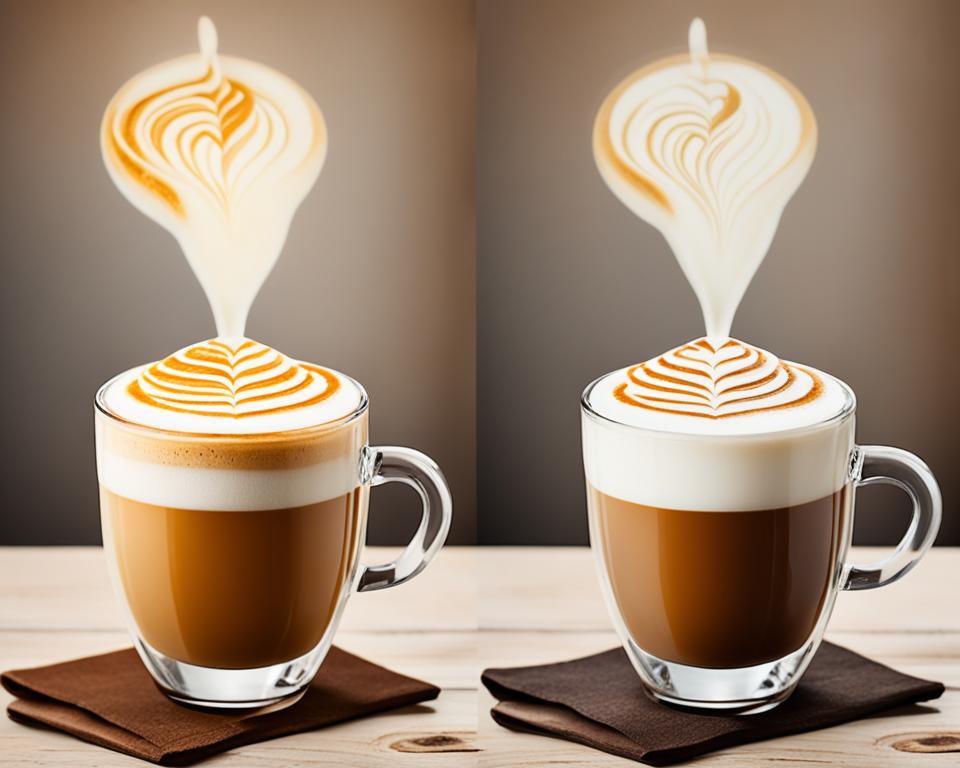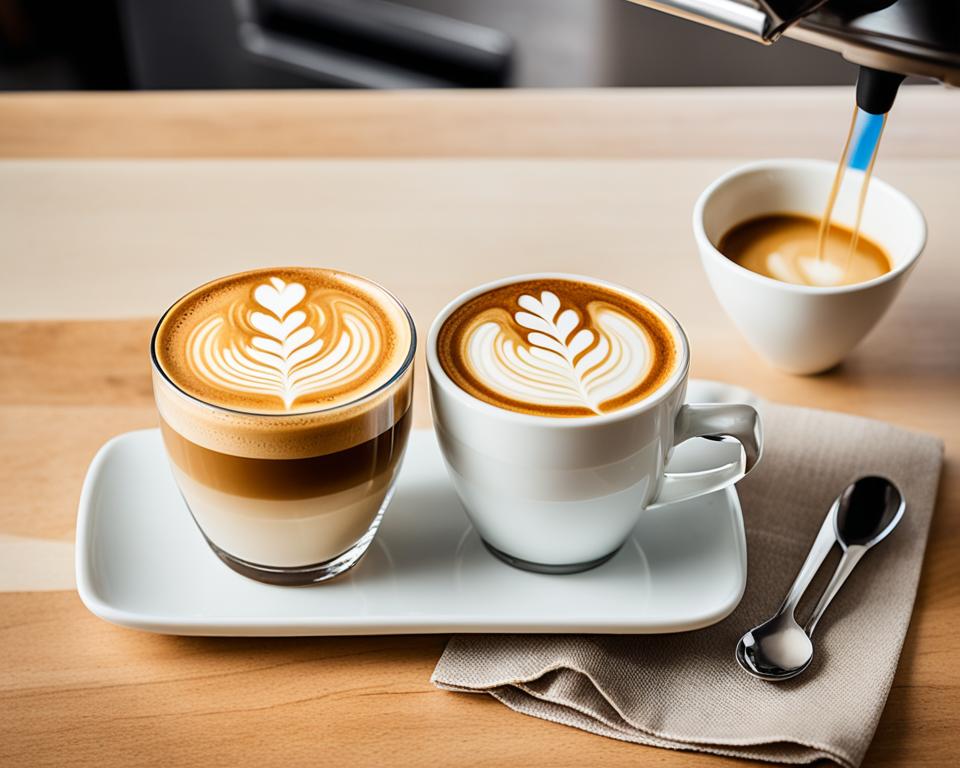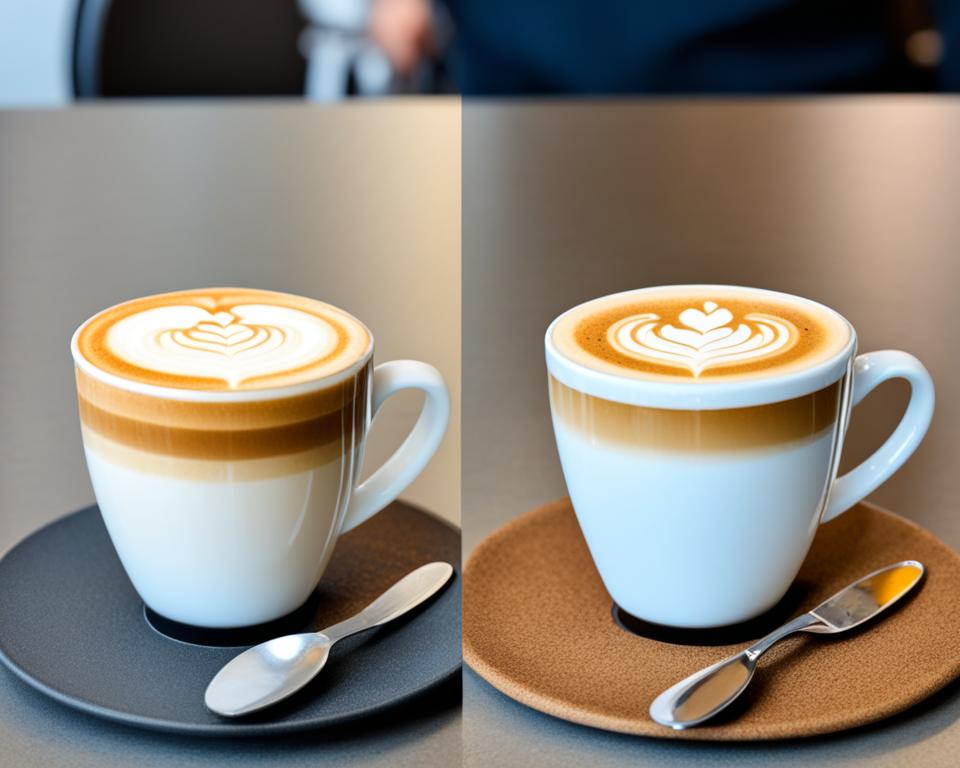Did you know that Americans consume about 400 million cups of coffee each day? With so many choices, it’s easy to get confused about popular espresso-based drinks like lattes and cortados. Let’s break down the key differences between latte and cortado coffee.
Understanding their milk-to-espresso ratio, texture, and taste can help you decide which drink to savour next.
In a latte, you’ll find a higher milk content, creating a creamy, often frothy beverage that’s perfect for enjoying a leisurely morning. Meanwhile, a cortado offers a balanced coffee experience with a 1:1 milk-to-espresso ratio, delivering a robust yet smooth taste.
Knowing these differences can enhance your appreciation for these coffee types and guide your next order at your favourite café.
Introduction to Latte and Cortado
Both latte and cortado have unique and rich histories in the world of coffee culture. Whether you’re a specialty coffee drink enthusiast or just curious about different latte ingredients and cortado definitions, understanding these drinks offers a delightful dive into the diverse world of coffee.

What is a latté?
A latte is a creamy delight that brings together espresso and steamed milk. The latte ingredients are simple yet full of potential, as baristas often craft beautiful latte art on top.
It’s a staple in many coffee shops and a favourite for those who love a milky, smooth coffee experience. Originating in Italy, the latte has become a beloved drink across the globe, deeply embedded in coffee culture.
What is a cortado?
On the other hand, a cortado is known for its balanced flavour profile, which is achieved by mixing equal parts espresso and warm milk. The cortado definition may vary slightly depending on where you are, but the core idea remains the same: a drink that perfectly marries boldness with smoothness.
This Spanish-origin drink has gained popularity worldwide, becoming an integral part of specialty coffee drinks. Its unique blend captures the essence of strong espresso, softened by just the right amount of milk.
Key Ingredients and Preparation
When it comes to coffee preparation, understanding the key components of a latte and a cortado is essential. For both beverages, the foundation is a rich espresso shot.
The type of espresso beans chosen plays a crucial role; many baristas prefer medium to dark roasts for their balanced yet complex flavour profiles.
The grind size is another critical factor. For a perfect espresso shot, the coffee grounds should be fine but not too powdery. This allows the water to extract the ideal amount of flavour and crema during the brewing process. If you’ve ever wondered why coffee shops have such intricate grinders, this is it!
After mastering the espresso, the next step is milk preparation. The technique behind steamed milk can vary, but achieving that silky, smooth texture is a universal goal among baristas.
The milk is steamed to create microfoam, tiny bubbles that give the milk its creamy texture. This step is an art in and of itself, requiring practice and a good steam wand.
To make a latte, you need a larger quantity of steamed milk, making it creamy and smooth. On the other hand, a cortado uses a smaller amount of steamed milk, striking a perfect balance between milk and espresso.

Besides the ingredients, the equipment used in coffee preparation is vital. High-quality espresso machines and steam wands can make a significant difference.
At home, you might not have a commercial espresso machine, but there are great home models and milk frothers available that can help you replicate the experience.
Embracing these barista techniques at home can be a fun and rewarding process. The satisfaction of pulling a perfect espresso shot and steaming milk to the right consistency is truly fulfilling. So, why not give it a try and bring a bit of the coffee shop magic into your own kitchen?
The Difference in Milk Ratios
One of the main differences between a latte and a cortado lies in how milk is used. The milk-to-espresso ratio and the texture of the milk create distinct taste experiences in these beverages.
Understanding this can help you appreciate the unique qualities of each drink.
Milk in a Latte
In a latte, the milk-to-espresso ratio leans heavily towards milk. This drink typically consists of one part espresso and three parts steamed milk. The key here is the frothed milk, which includes microfoam that adds a velvety texture to the latte.
This creates a creamy, smooth drink consistency that is perfect for enjoying intricate latté art. I love how this balance of milk mellows out the strong flavour of the espresso, making it a delightfully comforting drink.
Milk in a Cortado
The cortado takes a different approach to its milk-to-espresso ratio. With equal parts milk and espresso, this drink ensures that the bold flavour of the espresso shines through.
The milk used in a cortado is typically only lightly frothed, resulting in a simpler drink consistency without the thick layer of microfoam found in lattes. This balance makes the cortado a perfect choice for those who enjoy the strength of espresso but want a slightly smoother finish.
It’s fascinating to see how this minimalist use of milk can completely change the experience of an espresso.
Flavour Profiles
Sipping on a latte or a cortado offers a splendid aromatic experience for coffee enthusiasts. A latte typically boasts a sweet and creamy texture, thanks to the generous amount of steamed milk that balances out the robust espresso flavour.
On the other hand, a cortado delivers a more concentrated coffee experience, with the coffee tasting notes being more pronounced due to the equal parts of espresso and warm milk.
When I indulge in a latte, I often savour its silky, sweet, and creamy texture, which offers just the right amount of mellowness. In contrast, a cortado provides a bolder taste where each sip highlights the delightful nuances of the espresso.
The unique balance achieved in a cortado offers a complex and enriched aromatic experience that’s hard to beat.
I find that the milk in a latte helps to mellow out the espresso, allowing for a softer, more approachable drink. It’s perfect for mornings when I want something comforting and smooth.
However, when I’m in the mood to experience the full spectrum of coffee-tasting notes, a cortado never disappoints with its strong, robust espresso flavour, heightened by just a splash of milk.
It’s rewarding to explore how milk can enhance—or tone down—different elements of the espresso in each drink.
Are Latte and Cortado Made from Different Types of Coffee or Espresso Beans?
Latte and cortado might seem similar, but they showcase different espresso preparations. While both use espresso, a latte incorporates more steamed milk, creating a creamier texture. In contrast, a cortado balances equal parts espresso and milk. This distinction highlights the importance of exploring the differences between coffee and espresso.
Conclusion
As we wrap up this delightful coffee journey, it’s clear that choosing the right coffee is deeply personal. A latte, with its creamy texture and frothy milk, offers a sweet and smooth experience. On the other hand, a cortado brings a bold yet balanced flavour that highlights the robust espresso.
Your personal coffee preference plays a significant role in the decision-making process. Do you enjoy a milky, comforting drink to savour over a casual conversation?
Or perhaps you prefer a stronger espresso flavour with just a hint of milk to start your day off right? Each drink caters to different moods and occasions, so there’s no one-size-fits-all answer.
I encourage you to explore both options and see where they fit into your coffee routine. Whether it’s a latté to unwind or a cortado to energise, each has its own unique charm.
So, next time you’re at your favourite coffee shop, think about your flavour affinities and enjoy the journey of finding your perfect cup. Happy sipping!
FAQ
What is the difference between a latte and a cortado coffee?
The main difference between a latte and a cortado coffee lies in the milk-to-espresso ratio. A latte typically uses a larger amount of steamed milk, creating a creamy texture and a milder coffee flavor. On the other hand, a cortado features an equal ratio of espresso to warm milk, resulting in a bolder, more balanced flavour.
What ingredients are in a latté?
A latte consists primarily of espresso and steamed milk, often with a small layer of milk foam on top. It’s commonly flavoured with a variety of syrups or spices and adorned with beautiful latte art.
What ingredients are in a cortado?
A cortado is made with equal parts espresso and warm milk. It does not typically include a significant amount of foam, focusing on achieving a strong yet smooth coffee flavour.
How do baristas prepare a latte?
Baristas prepare a latte by pulling a shot of espresso and then steaming milk to create a rich, velvety texture. The steamed milk is poured over the espresso, and sometimes latte art is crafted to enhance the visual presentation.
How do baristas prepare a cortado?
To prepare a cortado, baristas pull a shot of espresso and add an equal amount of warm milk. The goal is to combine the espresso and milk evenly, ensuring a harmonious balance of flavours without too much foam.
What is the significance of milk ratios in a latte?
In a latte, the milk-to-espresso ratio is crucial for achieving its signature creamy texture and mild flavor. The frothy milk creates a velvety consistency that balances the intensity of the espresso.
What is the significance of milk ratios in a cortado?
In a cortado, the equal milk-to-espresso ratio ensures a bold and smooth flavour profile. The reduced amount of milk allows the robust espresso flavours to shine while still providing a silky mouthfeel.
What flavour notes can I expect from a latte?
A latte offers a sweet and creamy texture, often highlighting the milk’s natural sweetness while mellowing the espresso’s bitterness. Depending on the type of beans used, you might also detect subtle chocolate, caramel, or nutty tones.
What flavour notes can I expect from a cortado?
A cortado presents a more robust espresso flavour with smoothness from the warm milk. It’s designed to balance the espresso’s strong notes, allowing nuanced flavours like fruitiness or spice from the beans to come through.
How should I choose between a latté and a cortado?
Your choice between a latte and a cortado can depend on your personal preference for coffee strength and texture. If you prefer a creamy, mild coffee experience, a latte might be your go-to. If you enjoy a balanced, more pronounced espresso flavour, a cortado is likely a better fit.




